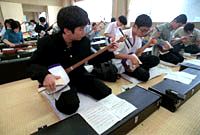RECLAIMING MUSICAL ROOTS:
Schools to Begin Teaching Traditional Instruments in 2002
March 5, 1999

Students at Higashi Sumiyoshi High School in Osaka Prefecture practice the three-stringed shamisen; others in the background work on the koto. (Jiji Press)
Instruments like the koto (zither), shakuhachi (flute), and taiko (drum) have been around in Japan for centuries, but the number of people who play them now has dwindled, and they play almost no part in daily life at all. While a fair number of people can say how many strings a guitar has, few know how many strings a koto has.
Soon, however, Japanese students will get to know these instruments firsthand because of a recent decision to introduce traditional Japanese musical instruments into the middle school curriculum from April 2002 (the Japanese school year begins in April). The aim is to enable children to enjoy traditional instruments alongside Western ones.
Western-Biased Music Education
Music education in Japan since the Meiji period (1868-1912), when the country ended two-and-a-half centuries of self-imposed isolation and launched a modernization drive, has been slanted completely toward the West. Most songs taught are Western-style songs, and the recorder is the most widely used instrument, followed by the piano, harmonica, drums, and other percussion instruments. Whenever Japanese children listen to music in the classroom, they nearly always hear Western classical music. During the nine years of compulsory education, they have almost no opportunities to come into contact with traditional Japanese music. And outside school, the most popular instrument that children learn is the piano; very few children learn to play a traditional native instrument.
All this may soon change, as the Ministry of Education announced revisions to the compulsory education curriculum at the end of 1998. One change was that from fiscal 2002 all students will be taught to play at least one Japanese instrument in music classes during three years of middle school. The moment proponents of Japanese music education have been waiting for will be realized at long last.
"The Koto Is Fun"
How will Japanese children respond to the unfamiliar instruments? Says one girl at an elementary school that has already introduced Japanese music instruction, "I didn't know anything about the koto until I played it in class, but it's a lot of fun. I like it second best after the piano." And although boys tend to be shy during music lessons, a boy says: "I'm glad I get to do something that other schools don't do. It's only natural to study a Japanese instrument in Japan, and I hope to continue playing from now on." Perhaps because the instrument is seldom seen, the children seem to be very interested indeed. At this school, the koto is used in music lessons from the third grade. Comments one teacher, "The score for the koto is easy to read, and it's fairly easy for children to play."
New Challenge for Teachers
Children are not the only ones who do not know traditional Japanese musical instruments; teachers, too, are in the same boat, having been brought up on Western music. Fortunately, the level of proficiency required to teach children the basics in Japanese music is not so high as to be unattainable. Teachers appear to be looking forward to teaching kids the new subject, moreover. Says one teacher, "Although it is important to know Western music, we should study our own culture, too." And another comments, "I want our children to become familiar with the greatness of their ancestors, who enjoyed music performed on instruments made with readily available materials."
Nevertheless, there are a number of problems that must be overcome. For example, the koto is quite expensive, and there is a shortage of appropriate musical scores. As one performer of Japanese instruments remarks, "I am delighted that children's attention will be turned toward Japanese music, but I don't think that schoolteachers, who have been educated only in Western music, will be able to give proper guidance immediately. We must also revise the university curriculum for training teachers."
 Edited
by Japan Echo Inc. based on domestic Japanese news sources. Articles presented
here are offered for reference purposes and do not necessarily represent
the policy or views of the Japanese Government.
|



















